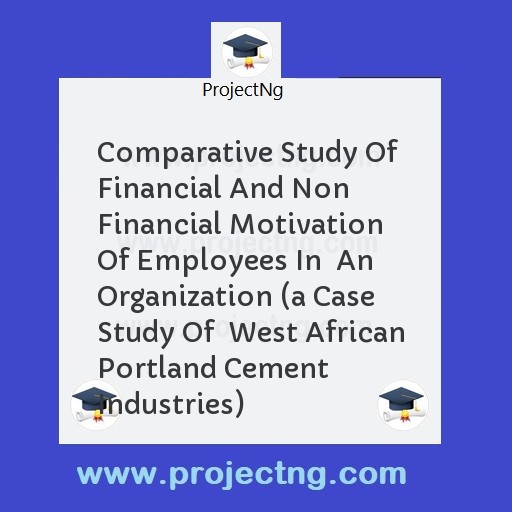Comparative Study Of Financial And Non Financial Motivation Of Employees In An Organization (a Case Study Of West African Portland Cement Industries)
Business Administration Project Topics
Get the Complete Project Materials Now! »
COMPARATIVE STUDY OF FINANCIAL AND NON FINANCIAL MOTIVATION OF EMPLOYEES IN
AN ORGANIZATION (A CASE STUDY OF
WEST AFRICAN PORTLAND CEMENT
INDUSTRIES)
Abstract
The main aim of this research work is to investigate the relationship of the two types of rewards namely financial rewards and non-financial rewards towards employees motivation. The research work was restricted towards manufacturing company that is, West African Portland Cement. Based on the past literature, it is found that financial rewards or money has become the main motivator for employees performance in an organization. Traditionally, little thought has been given to the impact of non-financial rewards as it does not hold any immediate monetary value to the employees. However, in the context of heightened awareness among employers and employees, there has been greater emphasis on non-financial rewards, such as praise and recognition as it holds a deep and greater impact to the employees especially in the long run. This work defines the nature of financial and non financial rewards on employees motivation. By undertaking a comparison between the financial and non-financial rewards, the outcome of this paper provides vital information for organizations to structure a better rewards plan for their employees.
CHAPTER 1
1.0 GENERAL INTRODUCTION
It is obvious that financial and non financial motivation of employees in an organization is very essential because it aids the performance evaluation of employees in various department section etc and also assist managers to know why worker behave in certain ways and really motivate them to perform well at work place.
Motivating the personnel of an organization to make minimum effort towards the attainment of its objectives has along occupied the mind of managers from the managing directors to the invest ranking supervisors. Managers should be aware of the fact that people of the same organization work for different reasons for example, if a manger looks at a group of workers performing the same job for some time he cannot observe that some workers perform better than others. In explaining this two variables come to mind immediately, one is the difference in degree of skill and ability displayed by individual works, the other variables can be describe as motivation therefore, to guide workers activities in the described direction, it is important for managers to know why workers behave in certain ways and what really motivate them to perform well at work place.
In an industrial organization, the importance of incentives cannot be over emphasized. Incentives are intended to stimulate the desire to work, they are eternal factors or condition brought to bear on individual to induce him to the right attitude to work. The order of an extra reward can be used in other to achieve minimum efficiency among workers. An adequate financial fair wages and salaries is further emphasized by the fact that they are reckoned in monetary terms. Financial uncreative is inform of increase in pay or bonus and also special holiday pay. Management must also give consideration to the environment in which the worker performs their works. They should be an atmosphere of co-operation and trust between the various works at all level. The proper display of equipment and proper lightening will ensure a smooth performance of the job. In addition the leader can be a motivator for his group, this depends on the quality of the relationship between him and group members. All groups as they begin to work together are highly dependent on the authority of the leader. A leader needs to be sensitive to the rule of group standard and their far reaching influence on efficiency and productivity for leadership to affects motivation, it must conform and identify group standard. The value of an incentive is the extent to which the workers responds by contributing to the best of his ability to the company’s success.
Finally, recognition of the effort of the workers is also important. All employees like to feel that their efforts are appreciated, particularly if some improvement is achieved. When the work become monotonous in nature, it militate against a positive attitudes by workers to the job. Job satisfaction can be improved by simple expedient of making the work more interesting and requiring a greater application of thought skill. This can be done by increasing the job content. The other method will be extend to the range of tax that has to be performed by individual workers.
1.1 Background of the Study
West African Portland Cement Plc was created in 1833 presently Lafarge cement Nigeria plc (WAPCO) was established in 1960 with its first factory in Ewekoro, Ogun state. The second factory in Sagamu, also in Ogun state was established in 1978. The company commenced production with an initial capacity of 200,000 tons per annum, but later grew with demand to about 1.5million tones per annum. This has led to an increase in the company capacity by over 1 million tons per annum.
The company has consistently won the Nigerian industrial standard (NIS) certificate for a quality product. The company was listed on the Nigeria stock exchange on February 16, 1979. In February 2008, the name West African Portland Cement plc was changed to Lafarge Cement WAPCO Nigeria plc, to reflect the rebirth of the company as part of an international organization, strategically positioned for greater heights.
WAPCO is the leader in building materials and hole top-ranking positions in all of its businesses such as cement, aggregates, concrete and gypsum, with more than 84,000 employees in 70 countries. WAPCO businesses are truely fundamental; it extracts mineral resources from the earth and transformed them into
Be the First to Share On Social

Enjoying our content?
Don't miss out on new videos! Subscribe to our YouTube channel for more awesome content.
Subscribe Now!













